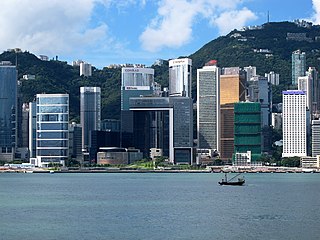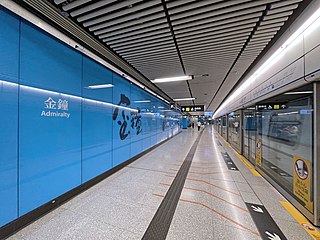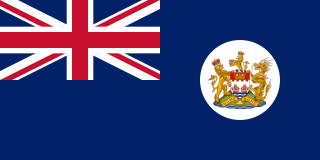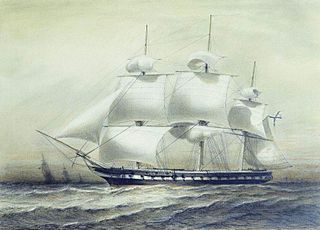
The Admiralty was the British government department responsible for the command of the Royal Navy until 1964, historically under its titular head, the Lord High Admiral – one of the Great Officers of State. For much of its history, from the early 18th century until its abolition, the role of the Lord High Admiral was almost invariably put "in commission" and exercised by the Lords Commissioner of the Admiralty, who sat on the governing Board of Admiralty, rather than by a single person. The Admiralty was replaced by the Admiralty Board in 1964, as part of the reforms that created the Ministry of Defence and its Navy Department.

HMS Belfast is a Town-class light cruiser that was built for the Royal Navy. She is now permanently moored as a museum ship on the River Thames in London and is operated by the Imperial War Museum.

Admiralty is the eastern extension of the central business district on the Hong Kong Island of Hong Kong. It is located on the eastern end of the Central and Western District, bordered by Wan Chai to the east and Victoria Harbour to the north.

HMS Morecambe Bay was a Bay-class anti-aircraft frigate of the British Royal Navy, named after Morecambe Bay on the north western coast of England. In commission from 1949 until 1956, she saw active service in the Korean War, and was sold to Portugal in 1961 to serve as NRP Dom Francisco de Almeida until 1970.

Sembawang is a planning area and residential town located in the North Region of Singapore. Sembawang planning area is bordered by Simpang to the east, Mandai to the south, Yishun to the southeast, Woodlands to the west and the Straits of Johor to the north.

Admiral Sir Edward Belcher was a British naval officer, hydrographer, and explorer. Born in Nova Scotia, he was the great-grandson of Jonathan Belcher, who served as a colonial governor of Massachusetts, New Hampshire, and New Jersey.

Admiralty is a Mass Transit Railway (MTR) station in Admiralty, Hong Kong. The station's livery is blue and white. Served by the largest number of lines of any MTR station at four: East Rail line, the Tsuen Wan line, the Island line, and the South Island line, Admiralty is a major interchange station within the MTR network.

Royal Navy Dockyards were state-owned harbour facilities where ships of the Royal Navy were built, based, repaired and refitted. Until the mid-19th century the Royal Dockyards were the largest industrial complexes in Britain.

British Forces Overseas Hong Kong comprised the elements of the British Army, Royal Navy and Royal Air Force stationed in British Hong Kong. The Governor of Hong Kong also assumed the position of the Commander-in-chief of the forces and the Commander British Forces in Hong Kong took charge of the daily deployment of the troops. Much of the British military left prior to the handover of Hong Kong to China in 1997. The present article focuses mainly on the British garrison in Hong Kong in the post Second World War era. For more information concerning the British garrison during the Second World War and earlier, see the Battle of Hong Kong.

The German East Asia Squadron was an Imperial German Navy cruiser squadron which operated mainly in the Pacific Ocean between the mid-1890s until 1914, when it was destroyed at the Battle of the Falkland Islands. It was based at Germany's Kiautschou Bay concession in China.

Board of Admiralties was a supreme body for the administration of the Imperial Russian Navy and admiralty shipyards in the Russian Empire, established by Peter the Great on December 12, 1718, and headquartered in the Admiralty building, Saint Petersburg. It included several other admiralties of the Imperial Russia among which is the Nikolaev Admiralty.

HMS Tamar was the name for the British Royal Navy's base in Hong Kong from 1897 to 1997. It took its name from HMS Tamar, a ship that was used as the base until replaced by buildings ashore.

Admiral Sir Geoffrey Layton, was a Royal Navy officer. He was in command of the submarine HMS E13 when, under attack from German vessels, it ran aground off the Danish coast during the First World War. Despite this incident, he rose to senior command in the Second World War and retired in 1947. His final appointment had been as Commander-in-Chief, Portsmouth.

The Holland 602 type submarine, also known as the H-class submarine, was one of the most numerous submarines of World War I. The type was designed by the Electric Boat Co. of the United States, but most of the boats were built abroad: in Canada by the subsidiary of the British Vickers company and in British shipyards.
HMS Thanet was an S-class destroyer of the Royal Navy. Built during, and commissioned shortly after the First World War, she went on to see service in the Second World War, being sunk early in 1942.

Pallada was a sail frigate of the Imperial Russian Navy, most noted for its service as flagship of Vice Admiral Yevfimy Putyatin during his visit to Japan in 1853, which later resulted in the signing of the Treaty of Shimoda of 1855, establishing formal relations between the two countries. In addition to her diplomatic mission, her crew also conducted numerous geographical and natural studies in the Far East. She was scuttled by her own crew in the Crimean War due to the poor condition of her hull in 1855.
Kuroshio Maru was a tanker that was built in 1938 for Japanese owners. She was chartered by the Imperial Japanese Navy and Imperial Japanese Army during World War II: the ship was sunk in January 1945 at Takao, Formosa by American aircraft. Salvaged in 1946, she was allocated as a war prize to China and renamed Yung Hao, but was forced to remain at Hong Kong by the British. She was requisitioned by the Admiralty during the Korean War and allocated to the Royal Fleet Auxiliary. She was to have been named RFA Surf Pilot but due to her poor condition she did not serve in the Royal Fleet Auxiliary. She served as Surf Pilot, a tender to HMS Terror until 1958 and was subsequently scuttled off Pulau Aur, Malaya in 1960.

The Glorious Revolution of 1688 rearranged the political map of Europe, and led to a series of wars with France that lasted well over a century. This was the classic age of sail; while the ships themselves evolved in only minor ways, technique and tactics were honed to a high degree, and the battles of the Napoleonic Wars entailed feats that would have been impossible for the fleets of the 17th century. Because of parliamentary opposition, James II fled the country. The landing of William III and the Glorious Revolution itself was a gigantic effort involving 100 warships and 400 transports carrying 11,000 infantry and 4,000 horses. It was not opposed by the English or Scottish fleets.
Admiralty station may refer to

An Admiralty is a governmental and/or naval body responsible for the administration of a navy.
















